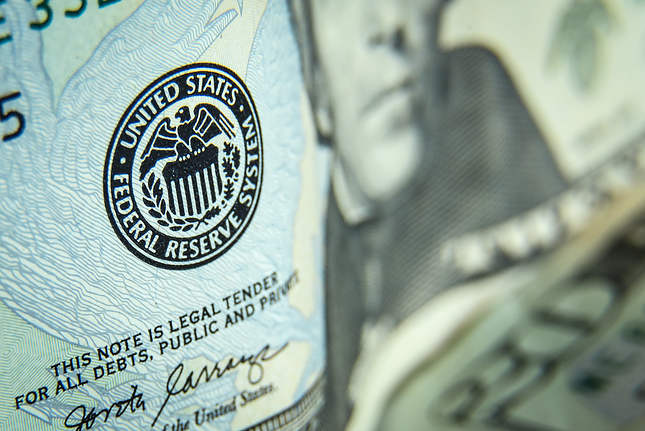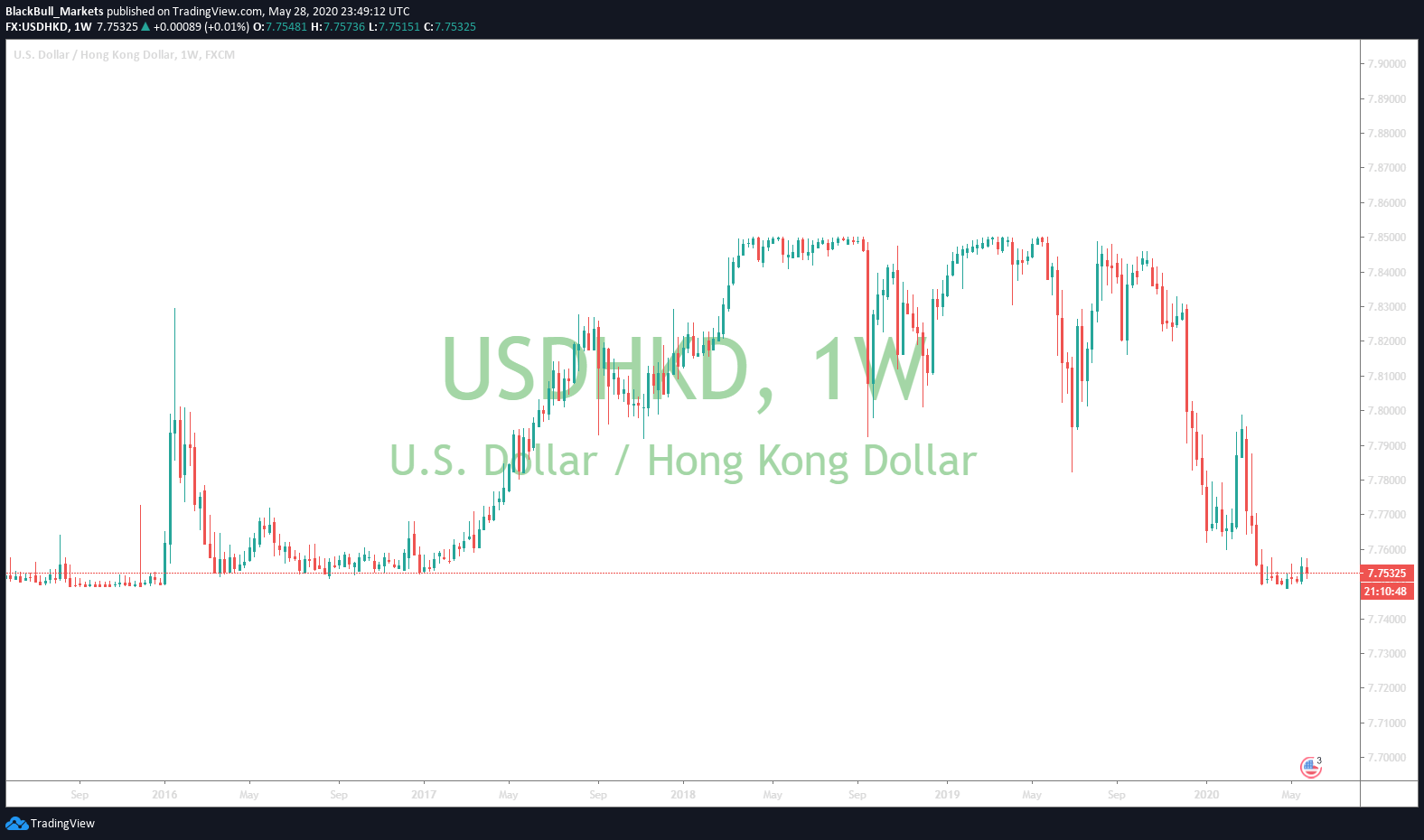The Hong Kong dollar is on its heels. The financial hub of Asia, which connects the East to the West has been in the middle of pissing contest between the United States and China, not to mention their domestic struggle between them and China. If protests for autonomy in Hong Kong continue, and President Trump implements drastic foreign policy measures against Hong Kong, extreme capital outflows may ensue, forcing the Hong Kong Monetary Authority to abandon its peg on the US dollar.
Could Donald Trump’s election woes force the peg to break?
As the November Election edges nearer, President Donald Trump risks losing the presidency due to his mismanagement of the Coronavirus. David Rocke describes his reopening the American Economy as “gambling for resurrection.” A branch of game theory, which essentially states everything that the President is doing with regards to the Coronavirus is perfectly rational. He has two choices: He does nothing drastic, the death increase, therefore basically ensuring his loss in the election. Or he reopens the economy, maybe squashes the curve, and promotes that it was a success, giving him a higher chance of winning the election. If that doesn’t work, well, he was going to lose the election anyway. As the Jobless claims reached 41 Million yesterday, President Trump is losing the grip on the election.
However, there is one thing the President has full control over – foreign policy. With a China conference set tomorrow, there a high possibility given his election chances that he implements drastic sanctions against Hong Kong to please his supporters. This is alongside Secretary Pompeo announcing that “It could no longer verify Hong Kong’s autonomy from China,” which gave it special trade exceptions with the U.S. This may put upwards pressure against the Hong Kong Dollar, which is pegged against the USD as the financial instability from the sanctions may cause extreme capital outflows. However, this alone may not cause a capital outflow, nor may the capital outflow force the peg to break. Hong Kong may impose restrictions on capital outflows for the time being.
History of the Hong Kong/US Dollar Peg
As the financial hub connecting the West to the East, Hong Kong teased investors with its free-flowing capital policies, with a promise of financial stability and consistency. In 1983, the currency was pegged to the USD. This was due tp Concerns regarding the future of Hong Kong after 1997, when the handover of control from the British to China was set to take place. The rate at which the Hong Kong dollar was pegged to the U.S. Dollar has changed over time, however, for the past 37 years, it has remained pegged to the U.S. currency. For the past 12 years since the Great recession, Hong Kong has flourished being the brokers between the East and the West. The pegged currency gave the country stability when it came to trade and investors.
However, history shows that pegged currencies are disastrous in extreme conditions
This was the case in the Thai Bhat in 1997 and the Argentinian Peso in 2000. In the case of the Thai Bhat, Thailand was experiencing high levels of growth from 1992 onwards as banks loosened restrictions, causing a lending boom and inflated real estate prices. However, from 1995 onwards, growth slowed, with investors increasingly worrying about the returns on their investments. This caused a massive capital outflow out of Thailand, devaluing the Thai Bhat. The government tried to prop up the currency by using its $38B USD foreign reserves. However, in half a year from the start of 1997, their foreign reserves dropped 93% to $2.65B before they stopped the regime.
The That Bhat subsequently depreciated against the USD, from 25 to 52 Thai Bhat per $1 USD.
Similarly, the Argentinian Peso shared the same fate in the 2000s. Argentina’s government was citing the control of inflation as the reason for pegging the currency. However, a multitude of socioeconomic factors such as an increase in income inequality and external shocks driving interest rates higher would see Argentina’s growing economy stall. With the Peso pegged to the USD 1:1, there was pressure for Argentina to keep the peg as most of its debt was denominated in U.S. dollars. However, restrictions on withdraws of 1000 Pesos/USD dollars pushed the sitting President, and the Minister of Economy resigned. The new finance minister imposed a new exchange rate of 1.4 to 1 U.S. dollar, however, what sealed the abandoning of the peg was when “pesification” of all the accounts in Argentina – which changed every single dollar that was in USD to Peso. This saw an increase in demand for the U.S. dollar – increasing the exchange rate from 1.4 pesos to 1 USD to around 4 Peso to 1 USD. Currently, 1 U.S. Dollar sits at 68 Argentinian Pesos. – Further reading, “Convertibility Law”.
What is the Catalyst for Hong Kong?
It will require a multitude of events to occur at the same time. The Hong Kong protests, for the most part, have been mainly domestic, with geopolitical parties watching from the sidelines. However, with China putting its foot down and enforcing national security law, the eyes of democracy have caught attention. President Trump stated that “we are not happy with China” with Larry Kudlow stating that China has made a “huge mistake” in passing the national security regarding Hong Kong. Carrie Lam, the Chief Executive of Hong Kong, assures Hong Kong citizens that the law will not undermine the freedom Hong Kong citizens face. However, she is on the side for the law passing, stating that “regrettably, the current legal system and enforcement mechanism for Hong Kong to safeguard national security [this is regarding the protests] are inadequate or even ‘defenseless.’ Despite returning to the Motherland for 23 years, Hong Kong has yet to enact laws to curb acts and activities that seriously undermine national security.”
Currently, Hong Kong’s Monetary Authority (HKMA) foreign reserve sits at around $441B U.S. dollar with Hong Kong using the Fed’s repo facility to its full advantage. The HKMA has the goal of pegging the currency between 7.75 – 7.85 HKD for 1 USD, and currently sits around the strong end of the band at7.752 as the HKMA bolsters the strength of the HKD during the Coronavirus. This may be in anticipation of a devaluing in the currency because of the Coronavirus and domestic tensions.
With the election on the horizon for Trump alongside China taking a strict stance against Hong Kong, fireworks may ensure as both sides battle it out. With Hong Kong directly in the firing line, all eyes are on what President Donald Trump imposes on Hong Kong tomorrow. The HKMA has enough foreign reserves to continue to prop up the HKD, given current circumstances. But the uncertainty with Hong Kong has finally started to settle in – not a feeling you want when your country was built on ensuring certainty and consistency within the Financial Markets. There is a chance that capital in Hong Kong talks themselves into pulling their money out of Hong Kong. If that occurs, the Hong Kong Dollar may serve the same fate as Thailand in 1997.
Risk Warning: Trading foreign exchange on margin carries a high level of risk and may not be suitable for all investors. The high degree of leverage can work against you as well as for you. Before deciding to trade foreign exchange, you should carefully consider your investment objectives, level of experience, and risk appetite. The possibility exists that you could sustain a loss of some or all of your initial investment and, therefore, you should not invest money you cannot afford to lose. You should make yourself aware of all the risks associated with foreign exchange trading and seek advice from an independent financial adviser if you have any questions or concerns as to how a loss would affect your lifestyle.
Recommended Content
Editors’ Picks

AUD/USD holds steady near 0.6250 ahead of RBA Minutes
The AUD/USD pair trades on a flat note around 0.6250 during the early Asian session on Monday. Traders brace for the Reserve Bank of Australia Minutes released on Monday for some insight into the interest rate outlook.

USD/JPY: Traders set for rocky 2025 on rediverging interest rates, Trump and North Korea
The Federal Reserve remains the primary driver of USD/JPY and may halt its rate-cut cycle in 2025. Bank of Japan officials will probably refrain from bigger rate hikes. Wild-card politics are set to stir this currency pair, reflecting a duel of safe-haven currencies.

Gold: Is another record-setting year in the books in 2025?
Gold benefited from escalating geopolitical tensions and the global shift toward a looser monetary policy environment throughout 2024, setting a new all-time high at $2,790 and rising around 25% for the year.

Week ahead: No festive cheer for the markets after hawkish Fed
US and Japanese data in focus as markets wind down for Christmas. Gold and stocks bruised by Fed, but can the US dollar extend its gains? Risk of volatility amid thin trading and Treasury auctions.

Bank of England stays on hold, but a dovish front is building
Bank of England rates were maintained at 4.75% today, in line with expectations. However, the 6-3 vote split sent a moderately dovish signal to markets, prompting some dovish repricing and a weaker pound. We remain more dovish than market pricing for 2025.

Best Forex Brokers with Low Spreads
VERIFIED Low spreads are crucial for reducing trading costs. Explore top Forex brokers offering competitive spreads and high leverage. Compare options for EUR/USD, GBP/USD, USD/JPY, and Gold.
